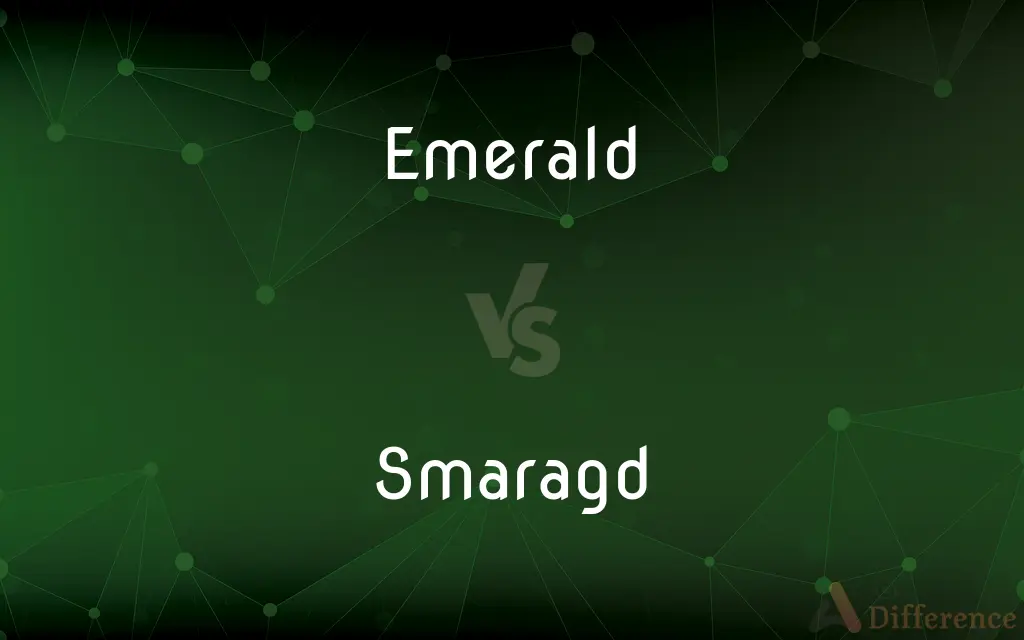Emerald vs. Smaragd — What's the Difference?
Edited by Tayyaba Rehman — By Maham Liaqat — Updated on May 2, 2024
Emerald and smaragd refer to the same gemstone, known for its rich green color; "emerald" is the commonly used English term, while "smaragd" is the historical and German name.

Difference Between Emerald and Smaragd
Table of Contents
ADVERTISEMENT
Key Differences
Emerald is a popular gemstone recognized for its vibrant green color and is considered one of the four traditional precious stones. In contrast, smaragd is simply the German and historical term for the same stone, used less frequently in English.
The term "emerald" is derived from the Old French word "esmeraude" and has roots in Latin and Greek, signifying its widespread use and recognition in the gemstone market. Whereas, "smaragd" originates from "smaragdos," an ancient Greek term that means green gem.
Emeralds are known for their presence in high jewelry and are often associated with luxury and richness. On the other hand, smaragd, while referring to the same mineral, is less commonly used in the global gem market but still holds significance in certain cultures and languages, especially in historical contexts.
The grading of emerald gemstones, based on color, clarity, cut, and carat weight, is a crucial aspect of their value. Similarly, smaragd, when it is used, refers to stones that meet the same criteria but may be seen more often in academic or mineralogical contexts.
While emerald is a term used globally in both commercial and casual contexts, smaragd is more prevalent in German-speaking countries and among gemologists and historians, indicating a cultural and contextual variation in usage.
ADVERTISEMENT
Comparison Chart
Common Usage
Widely used in English
Used in German and historical texts
Etymology
From Old French "esmeraude"
From Greek "smaragdos"
Context of Use
Jewelry, luxury goods
Academic, gemological
Recognition
One of the four precious gemstones
Same gemstone, less recognized name
Cultural Prevalence
Global
Primarily German-speaking regions
Compare with Definitions
Emerald
A precious gemstone known for its rich green color.
The necklace was adorned with a striking emerald centerpiece.
Smaragd
The German term for the gemstone emerald.
He gifted her a beautiful smaragd for her birthday.
Emerald
Sourced primarily from countries like Colombia and Brazil.
Colombian emeralds are renowned for their vibrant green hue.
Smaragd
Used in specific cultural or linguistic contexts.
In German gemological studies, the term smaragd is still used.
Emerald
Evaluated based on the four Cs: color, clarity, cut, and carat.
The emerald's value increased due to its impeccable clarity.
Smaragd
Refers to the same physical and chemical properties as emerald.
The smaragd displayed excellent hardness and a deep green color.
Emerald
Believed to have mystical and healing properties.
In ancient times, emeralds were worn as talismans for healing.
Smaragd
Historically used in older texts and descriptions of gems.
Medieval manuscripts often referred to emeralds as smaragd.
Emerald
Often associated with symbols of wealth and prosperity.
Emeralds have long been prized as royal jewels.
Smaragd
Recognized in the same grading and valuation systems.
This smaragd was graded highly for its outstanding color saturation.
Emerald
Emerald is a gemstone and a variety of the mineral beryl (Be3Al2(SiO3)6) colored green by trace amounts of chromium and/or sometimes vanadium. Beryl has a hardness of 7.5–8 on the Mohs scale.
Smaragd
Of or relating to emeralds.
Emerald
A bright green precious stone consisting of a chromium-rich variety of beryl
An emerald necklace
Smaragd
Having the color of emeralds.
Emerald
A bright green colour
The sea glistened in shades of emerald and jade
Smaragd
Also sma·ragd (smə-răgd, smărăgd′) Emerald.
Emerald
A slender-bodied green moth, the colour of which tends to fade as the moth ages.
Smaragd
(obsolete) An emerald.
Emerald
A hawker dragonfly with a metallic green body.
Smaragd
The emerald.
Emerald
A small hummingbird with bright metallic green plumage and darker wings and tail, found mainly in the area of the Caribbean and Central America.
Emerald
Bright green in colour
Beyond the airport lay emerald hills
Emerald
A brilliant green to grass-green transparent variety of beryl, used as a gemstone.
Emerald
A strong yellowish green.
Emerald
Of a strong yellowish green.
Emerald
Any of various green gemstones, especially a green transparent form of beryl, highly valued as a precious stone.
Emerald
Emerald green, a colour.
Emerald
Any hummingbird in the genera Chlorostilbon and Elvira; and some in the genus Amazilia
Emerald
(entomology) Any of various species of dragonfly of the family Corduliidae.
Emerald
A size of type between nonpareil and minion, standardized as 6½-point.
Emerald
Of a rich green colour.
Emerald
To ornament with, or as if with, emeralds; to make green.
Emerald
A precious stone of a rich green color, a variety of beryl. See Beryl.
Emerald
A kind of type, in size between minion and nonpare l. It is used by English printers.
Emerald
Of a rich green color, like that of the emerald.
Emerald
A green transparent form of beryl; highly valued as a gemstone
Emerald
A transparent piece of emerald that has been cut and polished and is valued as a precious gem
Emerald
The green color of an emerald
Common Curiosities
Are emeralds found only in Colombia?
While Colombia is famous for its emeralds, they are also found in Brazil, Zambia, and other countries.
What does "smaragd" mean?
"Smaragd" is derived from the Greek "smaragdos," meaning green gem.
What are the healing properties of emeralds?
Emeralds are believed to promote healing, balance, and vitality according to various cultural traditions.
How are emeralds graded?
Emeralds are graded based on their color, clarity, cut, and carat weight, similar to other precious gemstones.
Where does the term "emerald" come from?
The term "emerald" comes from the Old French "esmeraude," which is derived from Latin and Greek origins.
Is smaragd recognized internationally?
While recognized, "smaragd" is not as widely used internationally as "emerald."
What is the difference between emerald and smaragd?
Both terms refer to the same gemstone; "emerald" is the English term, and "smaragd" is the German and historical term.
What makes an emerald valuable?
The value of an emerald is primarily determined by its color, clarity, and rarity.
Can the term "smaragd" be used interchangeably with emerald in English?
While technically correct, "smaragd" is less commonly used and is more typical in German or historical contexts.
What are the main sources of emeralds worldwide?
The main sources include Colombia, Brazil, Zambia, and a few other regions noted for specific characteristics of the stones.
Share Your Discovery

Previous Comparison
Aft vs. Astern
Next Comparison
Soggy vs. SaggyAuthor Spotlight
Written by
Maham LiaqatEdited by
Tayyaba RehmanTayyaba Rehman is a distinguished writer, currently serving as a primary contributor to askdifference.com. As a researcher in semantics and etymology, Tayyaba's passion for the complexity of languages and their distinctions has found a perfect home on the platform. Tayyaba delves into the intricacies of language, distinguishing between commonly confused words and phrases, thereby providing clarity for readers worldwide.
















































